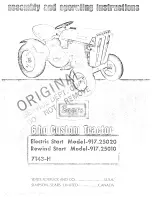
.
SAFETY
PRECAUTIONS FOR MAINTENANCE
PRECAUTIONS WITH HIGH-PRESSURE OIL
The hydraulic system is always under internal pressure. In addition, the fuel piping is also under internal pressure
when the engine is running and immediately after the engine is stopped. When performing inspection or
replacement of the piping or hoses, check that the internal pressure in the circuit has been released. If this is not
done, it may lead to serious personal injury or death. Always observe the following.
Do not perform inspection or replacement when the circuit is still under pressure.
Release the pressure in the hydraulic circuit. For details, see "METHOD OF RELEASING PRESSURE IN
HYDRAULIC CIRCUIT (PAGE 4-89)".
If there is any leakage from the piping or hoses, the surrounding area will be wet, so check for cracks in the piping
and hoses and for swelling in the hoses.
When perform inspection, wear protective eyeglasses and leather gloves.
There is a hazard that high-pressure oil leaking from small holes
may penetrate your skin or cause loss of sight if it contacts your
skin or eyes directly. If you are hit by a jet of high-pressure oil
and suffer injury to your skin or eyes, wash the place with clean
water, and consult a doctor immediately for medical attention.
PRECAUTIONS WITH HIGH-PRESSURE FUEL
When the engine is running, high-pressure is generated in the engine fuel piping. When performing inspection or
maintenance of the fuel piping system, stop the engine and wait for at least 30 seconds to allow the internal pressure
to go down before starting the operation.
HANDLING HIGH-PRESSURE HOSES AND PIPING
If oil or fuel leaks from high-pressure hoses or piping, it may cause fire or misoperation, and lead to serious
personal injury or death. If the hose or piping mounts are loose or oil or fuel is found to be leaking from the mount,
stop operations and tighten to the specified torque.
If any damaged or deformed hoses or piping are found, consult your Komatsu distributor.
Replace the hose if any of the following problems are found.
Damaged hose or deformed hydraulic fitting.
Frayed or cut covering or exposed reinforcement wire layer.
Covering swollen in places.
Twisted or crushed movable portion.
Foreign material embedded in covering.
NOISE
When performing maintenance of the engine and you are exposed to noise for long periods of time, wear ear covers
or ear plugs while working.
If the noise from the machine is too loud, it may cause temporary or permanent hearing problems.
2 - 36
Summary of Contents for D475A-5E0
Page 2: ... 1 1 ...
Page 14: ... 2 1 ...
Page 53: ... ...
Page 54: ... 3 1 ...
Page 243: ... ...
Page 244: ... 4 1 ...
Page 301: ... MAINTENANCE SERVICE PROCEDURE MAINTENANCE SERVICE PROCEDURE A Right of machine 4 58 ...
Page 338: ... 5 1 ...
Page 340: ... 6 1 ...
Page 401: ... ...
















































